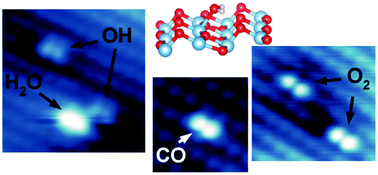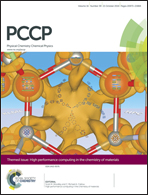Identification of adsorbed molecules via STM tip manipulation: CO, H2O, and O2 on TiO2 anatase (101)†
Abstract
While Scanning Tunneling Microscopy (STM) has evolved as an ideal tool to study surface chemistry at the atomic scale, the identification of adsorbed species is often not straightforward. This paper describes a way to reliably identify H2O, CO and O2 on the TiO2 anatase (101) surface with STM. These molecules are of a key importance in the surface chemistry of this and many other (photo-) catalytic materials. They exhibit a wide variety of contrasts in STM images, depending on the tip condition. With clean, metallic tips the molecules appear very similar, i.e., as bright, dimer-like features located in the proximity of surface Ti5c atoms. However, each species exhibits a specific response to the electric field applied by the STM tip. It is shown that this tip–adsorbate interaction can be used to reliably ascertain the identity of such species. The tip–adsorbate interactions, together with comparison of experimental and calculated STM images, are used to analyse and revisit the assignments of molecular adsorbed species reported in recent studies.


 Please wait while we load your content...
Please wait while we load your content...